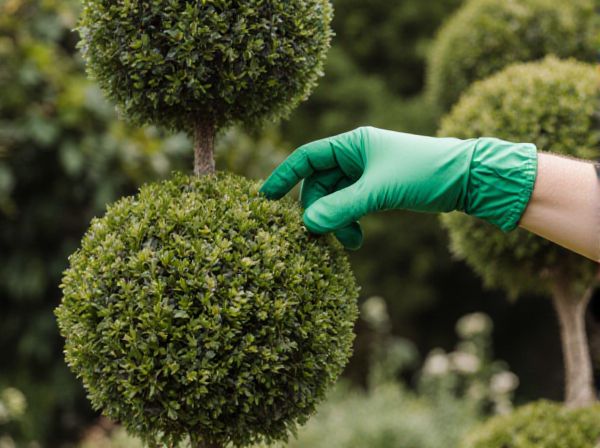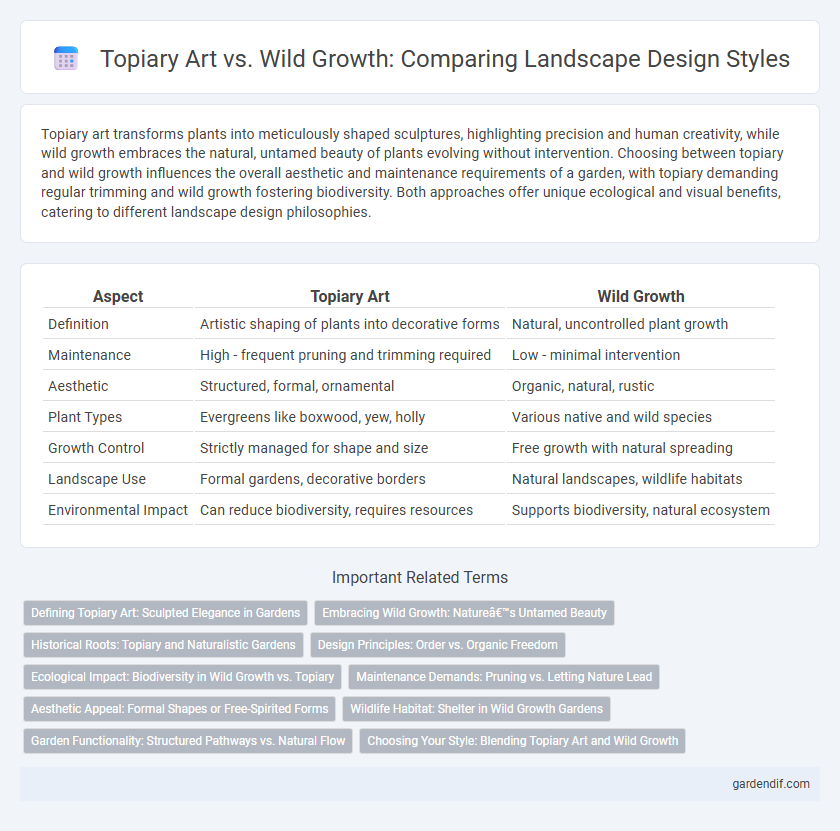
Topiary Art vs Wild Growth Illustration
Topiary art transforms plants into meticulously shaped sculptures, highlighting precision and human creativity, while wild growth embraces the natural, untamed beauty of plants evolving without intervention. Choosing between topiary and wild growth influences the overall aesthetic and maintenance requirements of a garden, with topiary demanding regular trimming and wild growth fostering biodiversity. Both approaches offer unique ecological and visual benefits, catering to different landscape design philosophies.
Table of Comparison
| Aspect | Topiary Art | Wild Growth |
|---|---|---|
| Definition | Artistic shaping of plants into decorative forms | Natural, uncontrolled plant growth |
| Maintenance | High - frequent pruning and trimming required | Low - minimal intervention |
| Aesthetic | Structured, formal, ornamental | Organic, natural, rustic |
| Plant Types | Evergreens like boxwood, yew, holly | Various native and wild species |
| Growth Control | Strictly managed for shape and size | Free growth with natural spreading |
| Landscape Use | Formal gardens, decorative borders | Natural landscapes, wildlife habitats |
| Environmental Impact | Can reduce biodiversity, requires resources | Supports biodiversity, natural ecosystem |
Defining Topiary Art: Sculpted Elegance in Gardens
Topiary art transforms garden spaces through meticulously sculpted greenery, shaping shrubs and trees into geometric or whimsical forms that showcase human creativity and precision. This horticultural technique emphasizes control and artistry, contrasting with wild growth where plants develop naturally without human intervention, resulting in organic and unpredictable landscapes. Sculpted topiary enhances garden aesthetics by introducing structure and elegance, creating focal points that highlight design intention and craftsmanship.
Embracing Wild Growth: Nature’s Untamed Beauty
Embracing wild growth in landscapes celebrates nature's untamed beauty by allowing plants to flourish organically without rigid shaping, creating dynamic, lush environments that support biodiversity. Wild growth fosters natural habitats, attracts pollinators, and reduces maintenance costs compared to the precise pruning required in topiary art. This approach highlights seasonal changes and ecological harmony, offering a vibrant contrast to the controlled symmetry of topiary designs.
Historical Roots: Topiary and Naturalistic Gardens
Topiary art dates back to ancient Roman gardens, where sculpted shrubs symbolized control and order, contrasting with the 18th-century rise of naturalistic gardens inspired by pastoral landscapes emphasizing organic growth and biodiversity. Topiary's historical roots lie in formal, geometric shapes that reflect human mastery over nature, while naturalistic gardens draw from the 18th-century English landscape movement championed by designers like Capability Brown who favored irregular, flowing plantings. The shift from topiary to wild growth reflects evolving cultural attitudes toward landscaping, balancing artifice with ecological harmony and visual spontaneity.
Design Principles: Order vs. Organic Freedom
Topiary art emphasizes geometric precision and controlled shapes, embodying design principles centered on order, symmetry, and intentional formality. In contrast, wild growth celebrates organic freedom, highlighting natural curves, irregular patterns, and spontaneous development within the landscape. Balancing these approaches involves integrating structured elements with naturalistic features to create visually dynamic and harmonious outdoor spaces.
Ecological Impact: Biodiversity in Wild Growth vs. Topiary
Wild growth supports higher biodiversity by providing natural habitats for various species, promoting ecological balance and resilience. Topiary art, while visually striking, often reduces habitat complexity and limits native flora and fauna diversity. Preserving wild growth enhances ecosystem services such as pollination and soil health, contributing to sustainable landscapes.
Maintenance Demands: Pruning vs. Letting Nature Lead
Topiary art requires regular, precise pruning to maintain its sculpted shapes, demanding consistent attention and skilled craftsmanship. In contrast, wild growth thrives with minimal intervention, relying on natural processes that reduce maintenance time and costs. The choice between structured topiary and free-form wild growth significantly impacts labor intensity and long-term landscape upkeep.
Aesthetic Appeal: Formal Shapes or Free-Spirited Forms
Topiary art showcases meticulously trimmed, geometric shapes that transform greenery into living sculptures, emphasizing symmetry and precision in landscape design. Wild growth embraces natural, unmanicured forms, offering a free-spirited aesthetic that fosters biodiversity and a relaxed, organic atmosphere. The contrast between topiary's formal elegance and wild growth's untamed beauty defines the core debate in garden aesthetics and visual harmony.
Wildlife Habitat: Shelter in Wild Growth Gardens
Wild growth gardens provide diverse shelter and nesting sites essential for local wildlife, supporting biodiversity by offering natural habitats for birds, insects, and small mammals. Unlike topiary art, which prioritizes aesthetic form and controlled shapes, wild growth encourages a variety of plants that create microhabitats and food sources critical for ecosystem health. Preserving wild growth areas enhances urban and suburban landscapes by fostering stable wildlife populations and promoting ecological balance.
Garden Functionality: Structured Pathways vs. Natural Flow
Topiary art creates structured pathways that guide movement and define garden spaces with precision, enhancing functionality through clear, intentional design. In contrast, wild growth promotes a natural flow, encouraging exploration and organic interaction with the landscape. Structured pathways benefit formal gardens requiring order, while natural flow suits informal gardens emphasizing biodiversity and ecological balance.
Choosing Your Style: Blending Topiary Art and Wild Growth
Blending topiary art with wild growth creates a dynamic landscape that balances structured elegance and natural freedom, enhancing biodiversity while maintaining aesthetic appeal. Opt for geometric topiary shapes alongside native plants to provide both visual interest and habitat value, promoting sustainable gardening practices. This fusion allows gardeners to tailor outdoor spaces that reflect both meticulous design and organic vibrancy, perfect for diverse environmental conditions.
Topiary Art vs Wild Growth Infographic

 gardendif.com
gardendif.com